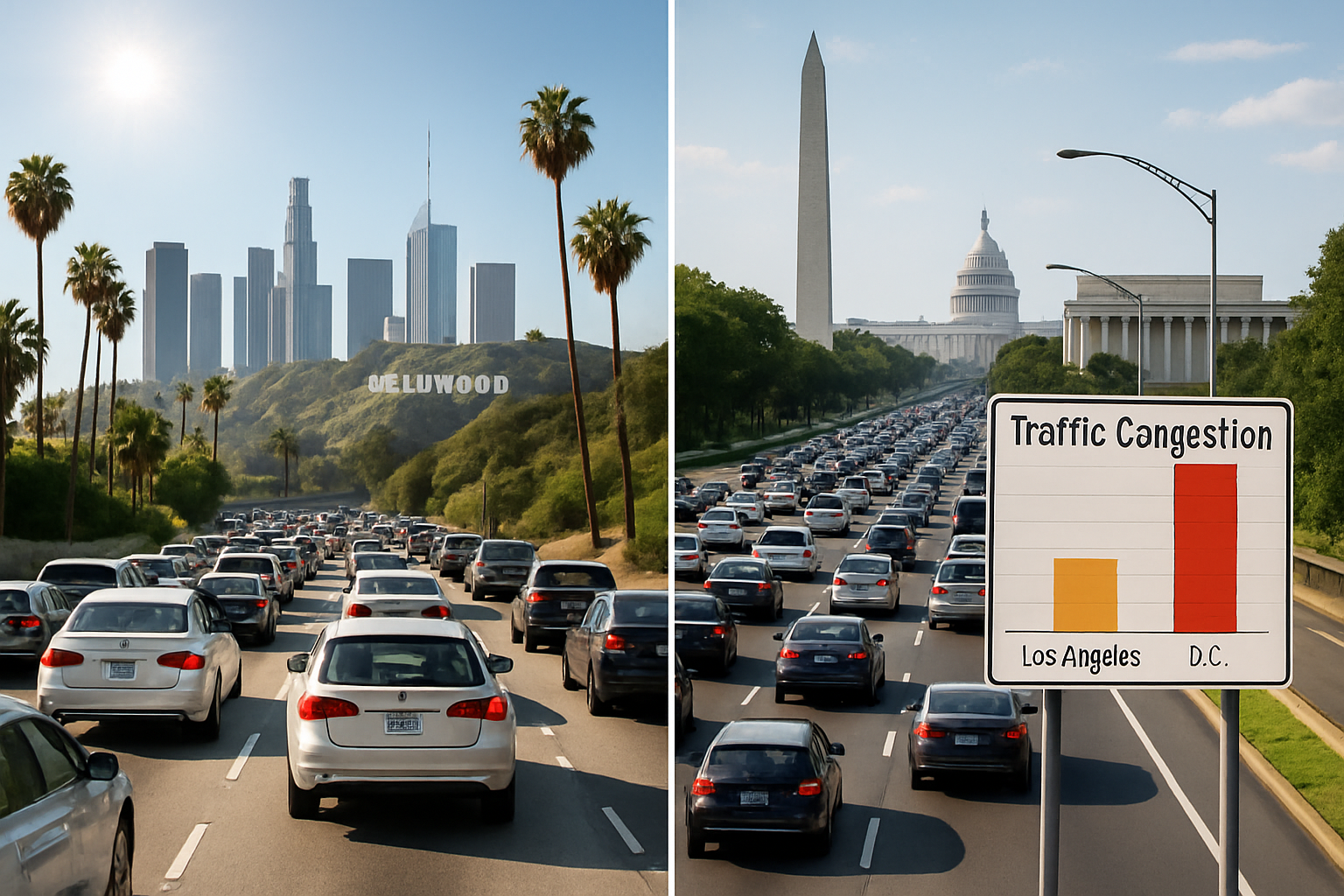For decades, Los Angeles has been the poster child for American traffic congestion—a city where commuters planned their lives around endless gridlock and freeways regularly transformed into fields of brake lights. But 2025 marks a significant shift in the urban traffic landscape: Los Angeles no longer holds the dubious crown of “the worst traffic in America.” Instead, Washington D.C. has overtaken L.A. for the top spot, according to the latest assessments by transportation analytics firms and ConsumerAffairs.
The End of an Era
The L.A. metro area’s reputation was forged over years of studies naming it the U.S. city where drivers lost the most hours to congestion. Previous research ranked Los Angeles consistently at the top, with average commute times stretching above 30 minutes and congestion lasting nearly eight hours on a typical weekday.
However, new analysis in 2025, drawing on a combination of metrics—average commute time, daily congestion duration, and rate of fatal crashes—finds that the nation’s capital now presents a worse everyday traffic experience than Southern California’s sprawling metropolis. Los Angeles has slipped to second place, while other cities such as Miami, San Francisco, and Atlanta round out the top five.
Why Did D.C. Surpass L.A.?
Several factors have contributed to Washington D.C.’s rise to the “top” of America’s traffic misfortunes:
- Longest Average Commute: The average commute in D.C. is now 33.4 minutes, the longest in the country. This is primarily driven by the city’s job distribution, with most employment concentrated in embassies, government offices, and the defense sector, but a widely spread residential population.
- Congestion Hours: Traffic bottlenecks in the D.C. metro area now last over six and a half hours daily, which accumulates to 71 days per year in traffic jams for the typical commuter.
- Pandemic Recovery Patterns: As federal employees have returned to the office post-pandemic—often encouraged by new government mandates—the volume of vehicles has surged beyond pre-2020 levels, with public transportation still not back to full ridership.
- Urban Density and Infrastructure Lag: Rapid population and economic growth in the D.C. area has put stress on existing road networks and transit options, aggravating gridlock.
What Has Changed in Los Angeles?
Los Angeles, despite nearly eight hours of weekday congestion and average commute times above 30 minutes, has seen relative improvement in its national standing. The city’s descent from the top spot stems from:
- Infrastructure Investments: A push towards expanding public transport ahead of the upcoming 2028 Olympics, as well as major roadwork and modernization projects, have provided incremental relief to commuters.
- Remote Work Trends: While driving has returned towards pre-pandemic levels, work-from-home policies remain more prevalent in California than in many East Coast cities, dampening the surge in rush-hour crowds.
- Geographic and Economic Shifts: Some Angelenos have moved away from traditional job hubs and adopted flexible work schedules, spreading out the daily rush.
Yet, it’s important to note that L.A. still leads the nation for weekday traffic congestion length—nearly eight hours—and drivers spend about 85 full days per year in traffic, so life on the freeways is far from easy. The city continues to battle legendary bottlenecks, particularly along famous stretches like the 405 and the 101.
Other U.S. Traffic Hotspots
The 2025 rankings also spotlight changes elsewhere:
| Rank | City | Average Commute Time (min) | Daily Congestion (hrs) |
| 1 | Washington D.C. | 33.4 | 6.5 |
| 2 | Los Angeles | 30.5 | 7.85 |
| 3 | Miami | 29.2 | 6.2 |
| 4 | San Francisco | 28.7 | 6.1 |
| 5 | Atlanta | 28.1 | 5.9 |
(Data compiled from 2025 ConsumerAffairs and national traffic studies.)
What This Means for Commuters
While L.A. may have lost its notorious title, it remains among the toughest cities in America for drivers, with heavy congestion still defining daily life. For Washington D.C. residents, however, the daily commute has become even more punishing, catalyzing new debates over public transit expansion, congestion pricing, and telework policies.
Ultimately, the shifting rankings underscore how changing work habits, city planning decisions, and demographic transformations continue to reshape America’s urban mobility challenges. For Angelenos, there’s modest cause for optimism—at least for now, someone else is suffering more on the road.

